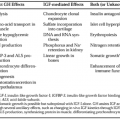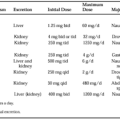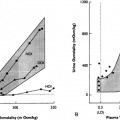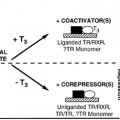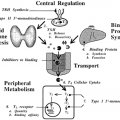CLASSIC PATHWAYS
AFFERENT PATHWAYS
Afferent pathways to hypothalamic nuclei arise primarily from the brainstem, thalamus, basal ganglia, cerebral cortex, and olfactory areas. The detailed anatomy of these connections and hypothalamic interconnections is described in several fine reviews.1,3,4 Briefly, the reticular formation and visceral centers of the brainstem connect with the hypothalamus through two prominent pathways, the mammillary peduncle and the dorsal longitudinal fasciculus. Visceral and somatic information also reaches the hypothalamus from the locus ceruleus, vagal nuclei, periaqueductal gray area, and nuclei of the solitary tract (Fig. 8-5). The fornix transmits fibers from the hippocampus by direct projections to the mammillary bodies. Additional afferents from the piriform cortex and the amygdala also reach the hypothalamus, probably by other routes. Olfactory information through the medial forebrain bundle and stria terminalis reaches the hypothalamus either directly or indirectly through the previously mentioned cortical regions, the stria terminalis being the primary pathway from the amygdala. Most of the afferent pathways are reciprocal; thus, the hypothalamic efferent connections are extensive.
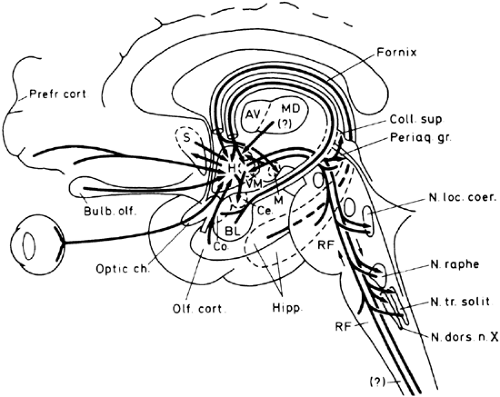 FIGURE 8-5. Major hypothalamic pathways. Pathways to the hypothalamus arise from several areas, including olfactory, limbic, and brainstem regions; reciprocal circuits exist, particularly to autonomic centers of the caudal medulla and spinal cord. The dorsal longitudinal fasciculus conveys most of the descending information to brainstem nuclei and is identified by the parallel, opposite arrows in this drawing. Another major pathway, the fornix, carries higher cortical information from the hippocampus (Hipp.) to the mammillary nucleus. (AV, nucleus ventralis anterior of thalamus; BL, Ce., and Co., basolateral, central, and cortical amygdaloid nuclei; Bulb. olf., olfactory bulb; Coll. sup., superior colliculus; H, hypothalamus; M, mammillary body; MD, dorsomedial thalamic nucleus; N. Dors. n. X, dorsal motor vagal nucleus; N. loc. coer., locus coeruleus; N. raphe, nuclei of the raphe; N. tr. solit., nucleus tractus solitarius; Olf. Cort., olfactory cortex; Optic ch., optic chiasma; Periaq. gr., periaqueductal gray; Prefr. cort., prefrontal cortex; RF, reticular formation; S, septum; VM, ventromedial hypothalamic nucleus.) (From Brodal A, ed. Neurological anatomy in relation to clinical medicine, 3rd ed. New York: Oxford University Press, 1981:698.)
Stay updated, free articles. Join our Telegram channel
Full access? Get Clinical Tree
 Get Clinical Tree app for offline access
Get Clinical Tree app for offline access

|
